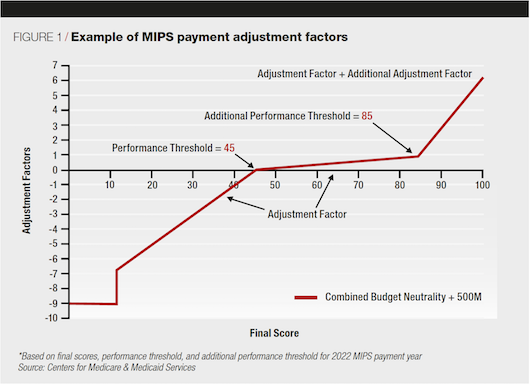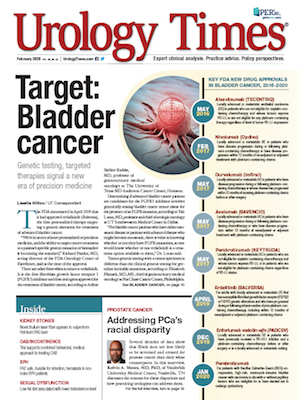Publication
Article
Urology Times Journal
Can you afford to avoid MIPS participation?
Author(s):
"Ignoring the entire Quality category may be a risky strategy in 2020 and beyond," warns Robert A. Dowling, MD.


The complexities of the Merit-based Incentive Payment System (MIPS) have prompted some physicians to claim they would rather absorb the penalties in Medicare payments than incur the costs of reporting under the program (bit.ly/ignoringmips). Indeed, one of the most common questions I am asked is, “Is MIPS really worth it?”
Remember that MIPS is not “optional” for most contemporary urology practices that wish to participate in Medicare. If minimum patient volume, service volume, and charges are exceeded, clinicians are automatically subject to MIPS, unless they are a qualified participant in an advanced alternative payment model. (Few urologists are participating in an advanced payment model as of 2019). So the real question is what is the potential upside, downside, and cost of participation?
In this article, I will examine some of the things you need to know and understand in order to answer that question in your practice.
First, let’s do a short review of how Medicare payment adjustments work under MIPS. Beginning in 2020 and continuing until 2024, the Medicare Physician Fee Schedule conversion factor is frozen (0% adjustments) under MACRA; while individual CPT codes may be revalued each year, the only opportunity to see the basic fee unit go up (or down) is through an adjustment under MIPS. That adjustment is determined by your MIPS Composite Score relative to certain thresholds that update each year and your relative performance to every other eligible clinician subject to MIPS.
Also by Dr. Dowling: CMS releases MIPS data; how does urology measure up?
Your score in any given year determines the payment adjustment 2 calendar years later. Payment adjustments are applied at the claim line level for professional services only (not drugs) and only on the Medicare payment amount (not the patient portion). For example, if your MIPS composite score was 95 in 2018, Medicare payment for 80% of an allowed charge of $100 line item would be adjusted up about 1.5% to $81.20.
MACRA and other pertinent laws require that payment adjustments under MIPS must be “budget neutral.” That means that any penalties (negative adjustments) projected to occur must be balanced by positive adjustments. Here is the key: Negative adjustments under MIPS are assigned on a linear scale between 0 and the maximum negative adjustment allowed under law for that particular year. Positive adjustments are also assigned on a sliding scale, but that scale is further adjusted by a scaling factor to be sure the projected positive adjustments do not exceed the negative adjustments (bit.ly/mipsadjustmentfacts) and subject to a maximum set by law.

In performance year 2 of MIPS (2018), the maximum negative adjustment was 5%, but because so many clinicians achieved positive scores, scaling had to be applied such that the maximum positive adjustment was only about 1.67% for a perfect MIPS composite score of 100. (This includes some adjustment for exceptional performance.) Results were similar in year 1 of MIPS.
The accompanying figure from the CY 2020 MPFS Final Rule (bit.ly/finalruleinfo) may make this a little easier to understand. In the current year 2020, a clinician must achieve a MIPS composite score of 45 to avoid a negative payment adjustment in 2022. A score of 30 would result in a –3% payment adjustment in 2022; a score of 20, a –5% adjustment; and a score of 0, a –9% adjustment. However, adjustments for scores over 45 cannot be determined until all of the projected penalties for negative adjustments are determined by actual results. Therein lies the uncertainty: The potential downside is clearer than the potential upside, according to the rules of the game as currently understood.
In order to calculate the cost of not participating in MIPS, one need only project the revenues for professional Medicare services for the year. For example, a mature, stable practice might have $400,000 in such revenue. The cost of ignoring MIPS altogether would be $36,000 (9%), a substantial penalty.
What about trying to just do the “easy” reporting to avoid some or all penalty? Quality reporting is without doubt the most time-intensive and complex part of the reporting burden for clinicians. What if you could just avoid that, which accounts for 45/100 points in 2020? The main problem with this approach is that you will have to score almost perfectly in the Promoting Interoperability category (25% weight) and the Improvement Activities category (15% weight), and do reasonably well in the Cost category (15% weight) to meet or exceed 45 points.
The Cost category is based on data that are not currently available to you (and there is no reporting burden/cost), so your only predictor of “success,” perhaps, is past performance. Furthermore, the threshold for 0 adjustment and the weight of the Cost category are increasing each year, leading to more uncertainty in the ability to predict your MIPS score in real time. Taken together, ignoring the entire Quality category may be a risky strategy in 2020 and beyond.
Next: Cost of participatingCost of participating
What is the cost of participating fully in MIPS, and is it offset by the upside? In our same example, a 1% positive fee schedule adjustment-$4,000-may not seem like much annual gross revenue. MIPS participation costs over and above baseline overhead might include: paying a consultant or EHR vendor for turnkey services (data collection and submission)-typically much less than $4,000/provider, registry fees (typically a few hundred per provider), paying an internal resource, and intangible costs like data entry (clinical staff and physicians) and tracking solely to support MIPS.
Again, most of these costs pertain to the Quality category and your experience will vary tremendously based upon your EHR vendor’s ability/willingness to create reports, export data, or communicate with qualified clinical data registries. Economies of scale are important, and large groups are better positioned to reduce the costs of participation/provider. Small practices may wish to investigate “virtual groups,” a relatively new option in MIPS designed to allow disparate practices to achieve economies of scale.
Read: How MIPS Cost category changes will affect urologists
With respect to the intangible burden of “data entry,” MIPS is simply an intermediate version of value-based care, the central paradigm of which is to improve quality and reduce cost. If your providers are having to click boxes in the EHR to document quality or your billing staff is applying G codes on claims, there may be an opportunity to reexamine their work flow to eliminate redundant work, or even take a fresh look at a newer EHR. Value-based care is probably here to stay, and the next generation of documentation should passively contribute to quality metrics, with minimal special effort by the user to separately comply with a government program.
Bottom line: There is now and for the foreseeable future a 9% negative fee schedule adjustment for practices that ignore MIPS because “it isn’t worth it.” While the costs of participation may offset or exceed the potential revenue increase in a small practice, these costs of data collection and reporting are the new normal in a value-based reimbursement paradigm and are likely to become the cost of doing business even outside of Medicare.

































